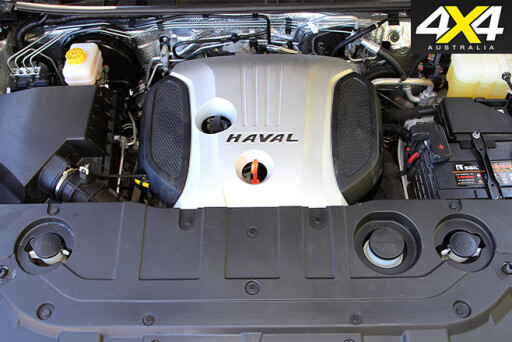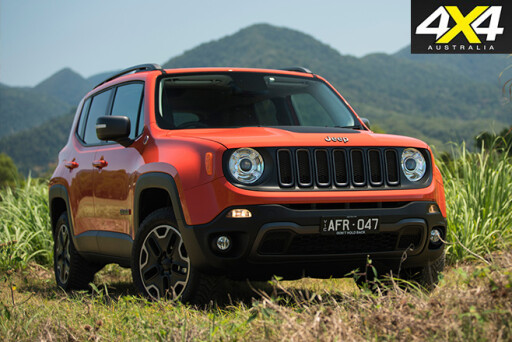.jpg )
IN RECENT years, road testing at 4X4 Australia has involved a near constant stream of turbo-diesels, with the odd petrol engine in the mix.
But this status quo was recently undone, with no fewer than three petrol vehicles – in a row – to road test, which has got to be some sort of record.
You may think: “Well, so what?” But there’s more to this tale than that. Two of those three petrol engines were small-capacity turbocharged fours rather than larger-capacity naturally aspirated fours, sixes or eights, all of which says much about where automotive engine development is heading right now.
First up was the Haval H9, a Chinese take on a Toyota Prado, save for its 2.0-litre turbocharged four-cylinder petrol engine. Otherwise, the H9 mimics the Prado in every way: six-speed auto; same body dimensions; seven seats with 150-Series folding, side-hinged single rear door; separate chassis; independent/coil front suspension; live-axle/coil rear suspension; and dual-range, full-time 4x4.
 All that means the Haval H9 shares its weight with the Prado and in the case of the test vehicle, 2236kg would seem a lot for a 2.0-litre petrol donk – even one with a turbo – to haul around. After all, the Prado comes with a 4.0-litre petrol V6 or a latest-design 2.8-litre turbo-diesel.
All that means the Haval H9 shares its weight with the Prado and in the case of the test vehicle, 2236kg would seem a lot for a 2.0-litre petrol donk – even one with a turbo – to haul around. After all, the Prado comes with a 4.0-litre petrol V6 or a latest-design 2.8-litre turbo-diesel.
Truth is, the Haval’s 2.0-litre four does very nicely. With its maximum torque on tap at an almost diesel-like 2000rpm, and then remaining undiminished for the next 2000rpm, it makes very useable and perfectly progressive power in that much-used rpm range.
The Haval’s engine bears an uncanny technical resemblance to Volkswagen’s current 2.0-litre TSI engine, a turbocharged petrol four that serves in a range of VW models however Haval says the design is “in-house”.
The engine has all the latest technical features you’d expect from a premium European brand, not from a Chinese – or even a Japanese – manufacturer. Those features include high-pressure direct fuel injection, a low-inertia dual-scroll turbocharger and an undersquare bore/stroke relationship designed to optimise the combustion chamber shape.
If the Haval’s small 2.0-litre engine did an excellent job of hauling more than two tonnes of heavy-duty Prado-like 4x4, then I was even more impressed by the second, and even smaller, turbo four, which boasts just 1.4 litres.
 This engine was sampled back-to-back with a 2.4-litre naturally aspirated petrol four, both of which are available in Jeep’s new baby wagon, the Renegade.
This engine was sampled back-to-back with a 2.4-litre naturally aspirated petrol four, both of which are available in Jeep’s new baby wagon, the Renegade.
The Fiat-designed 1.4-litre turbo is the default engine in the Renegade range, with the off-road-pitched Trailhawk being the only model using the Chrysler-designed 2.4-litre.
Interestingly, the 1.4-litre turbo claims a maximum of 230Nm, the same as the 2.4 but where the 1.4-litre’s peak torque is available from just 2500rpm, the 2.4 needs 4400rpm to achieve the same peak. Ultimately the 2.4-litre makes more power than the 1.4-litre (129kW versus 103kW), but it needs an additional 1000rpm to do so.
With its stronger torque at much lower engine speeds, the 1.4 is more eager and responsive than the atmo 2.4, and it does that with just six speeds inits dual-clutch sequential gearbox – the 2.4-litre has nine speeds to call on via its ZF auto transmission.
 Being a much smaller-capacity engine, the 1.4-litre is noticeably smoother than the sometimes buzzy 2.4, due to the less than ideal dynamic balance of an in-line four, especially in bigger capacities and at higher revs.
Being a much smaller-capacity engine, the 1.4-litre is noticeably smoother than the sometimes buzzy 2.4, due to the less than ideal dynamic balance of an in-line four, especially in bigger capacities and at higher revs.
The lesson here is if turbo-diesels fall over due to emission regulations, then the small-capacity turbo-petrol engine is ready for more widespread duty.
History Lesson
THE IDEA of increasing an engine’s power output by forcing air into its combustion chambers, rather than having the engine draw in the air itself, is as old as the internal combustion engine. Indeed, Gottlieb Daimler, the automobile’s ‘father’, patented a gear-driven air compressor (or supercharger as we know it today) as early as 1885.
The first turbocharger, or exhaust-gas-driven air compressor, was patented in 1905, but the idea wasn’t put into practice until World War I, where turbos started to appear on military aircraft engines.
Turbos first appeared in passenger cars in 1962, when General Motors produced both the Oldsmobile Cutlass Jetfire and the far more controversial rear-engined Chevrolet Corvair Monza Spyder for the USA market.
For various reasons neither car was a success, but the future of turbocharged road cars became assured when BMW launched its 2002 Turbo in 1973 and Porsche its 911 Turbo the following year.

COMMENTS